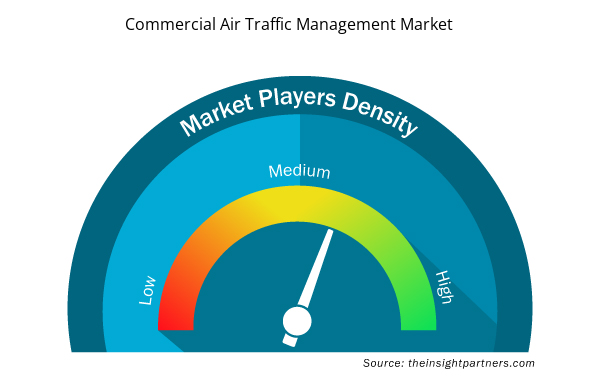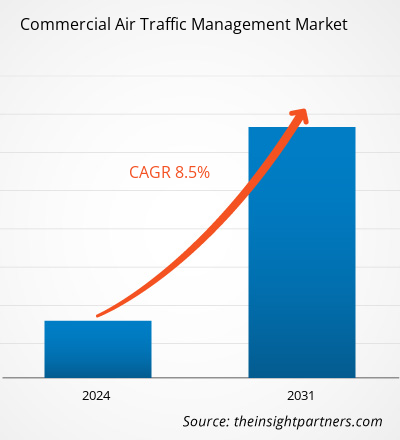商业空中交通管理市场规模预计将从 2023 年的 58.4 亿美元增至 2031 年的 112 亿美元。预计 2023-2031 年期间市场复合年增长率将达到 8.5%。新建机场的启动和现有机场的扩建以加速新设施需求可能仍将是市场的主要趋势。
商业空中交通管理市场分析
商业空中交通管理市场的买家包括商业机场及其管理机构,他们正不断投资采购先进的空中交通管理 (ATM) 解决方案,以实现高效、安全的航空运营。目前,机场建设项目正在进行中,使得买家的购买力适中。然而,随着机场建设接近尾声,对 ATM 解决方案的需求将会增加,从而提高买家的议价能力。此外,商业 ATM 系统的使用寿命很长,因此目前买家的议价能力较低。然而,在机场更新新 ATM 系统期间,特别是现有的 ATM 系统,预计会在未来几年提高买家的议价能力。
商业空中交通管理市场概况
全球商业空中交通管理市场生态系统的主要利益相关者包括零部件制造商、硬件制造商、软件提供商、政府部门和最终用户。在全球商业空中交通管理市场运营的零部件制造商提供发射器、天线、接收器、指示器、电池、灯、传感器和其他设备。所有这些零部件的及时供应对于空中交通管理系统制造厂的高效运营至关重要。如果这些零部件供应商的运营受到任何影响,空中交通管理系统的生产就会延迟,从而直接影响商业空中交通管理市场。
定制此报告以满足您的需求
您可以免费定制任何报告,包括本报告的部分内容、国家级分析、Excel 数据包,以及为初创企业和大学提供优惠和折扣
- 获取此报告的关键市场趋势。这个免费样品将包括数据分析,从市场趋势到估计和预测。
商业空中交通管理市场驱动因素和机遇
持续的产品创新和发布
全球航空业正在向新产品和创新产品转型。各行业利益相关者不断投资研发,以创新和开发强大的解决方案来简化工业运营。近年来,对空中交通管理系统的需求不断增长,迫使市场参与者投资开发新产品和创新产品。以下是一些主要产品开发:
- 2022 年 7 月,欧洲空中交通管制组织发布了更新的空中交通管理监视跟踪器和服务器 (ARTAS)。新版本 (V 9.0.2) 有几个新的社区功能,其中报告的问题已得到解决。
- 2022 年 6 月,Indra Sistemas SA 和欧洲空中导航安全组织马斯特里赫特上区管制中心 (MUAC) 宣布部署航空电信网络 (ATN) 和自动相关监视合同系统 (ADS-C),使空中交通管制系统能够准确管理空中交通。
- 2022年6月,泰雷兹公司宣布推出HELIXVIEW,这是一款符合C3标准的扫描仪,它结合了基于X射线纳米技术的电子扫描和3D成像重建,为机场提供更高的安全性,并为乘客提供无缝的旅行设施。
这些发展推动了全球商业空中交通管理市场的增长。
远程和虚拟塔的采用率不断上升
远程和虚拟塔有助于远程管理和维护空中交通运营。世界各地的各个机场都采用了这些塔,以实现更快、更安全的机场运营。2022 年 6 月,布林迪西机场在意大利启用了第一座远程管理控制塔。新的远程数字塔将帮助空中交通管制员从远程塔模块管理起飞、降落和地面操作。该模块还将协助空中交通管理,提高机场的安全性和运营效率。2022 年 5 月,德国北部的布伦瑞克-沃尔夫斯堡和埃姆登机场宣布委托 DFS Aviation Services GmbH (DAS) 和 Frequentis 在该地区建造一个远程塔中心,该中心计划于 2024 年中期开始运营。因此,为实现高效的空中交通管理,越来越多地采用和投资远程和虚拟塔,预计将推动商业空中交通管理市场的增长。
商业空中交通管理市场报告细分分析
有助于得出商业空中交通管理市场分析的关键部分是类型、组件、应用和机场等级。
- 根据类型,商业空中交通管理市场细分为空中交通服务、空中交通流量管理和空域管理。空域管理部门在 2023 年占据了更大的市场份额。
- 根据组件,商业空中交通管理市场分为硬件和软件。硬件部分在 2023 年占据了更大的市场份额。硬件部分进一步细分为雷达、天线、显示系统等。
- 根据应用,商业空中交通管理市场细分为通信、导航、监视、交通管制等。监视部分在 2023 年占据了更大的市场份额。导航部分进一步细分为 CVOR、DVOR、DME、ILS、DF 和 NDB。监视部分进一步细分为 PSR、SSR 和 MLAT。
- 根据机场等级,商业空中交通管理市场分为 I 级、II 级、III 级和 IV 级。I 级机场在 2023 年占据了较大的市场份额。
商业空中交通管理市场份额分析(按地区)
商业空中交通管理市场报告的地理范围主要分为五个地区:北美、欧洲、亚太、中东和非洲、南美。
2023 年,北美占据了市场主导地位,其次是欧洲和亚太地区。此外,亚太地区很可能在未来几年超越北美市场,并实现最高的复合年增长率。美国在 2023 年主导了北美商业空中交通管理市场。这主要是因为美国航空业是全球航空业的主要国家之一。该国拥有数量最多的飞机机队,每年可满足数百万乘客的需求。例如,2023 年美国航空公司的乘客数量超过 8.62 亿人次。客流量的增加导致美国航空公司采购更多的飞机机队,并对 ATM 运营产生更多需求。此外,美国不同机场现有 ATC 塔的升级和美国不同机场新 ATC 塔的投入使用正在催化全国商业空中交通管理市场的增长。全国多个机场都经历了不同的扩建过程,其中还包括新航站楼、ATC 塔的建设以及机场其他部门的升级。例如,2022 年 8 月,菲尼克斯-梅萨关口机场将空中交通管制塔商业化,以处理亚利桑那州机场日益增长的空中交通。同样,美国联邦航空管理局 (FAA) 正在实施多项机场计划,以升级其空中交通管理系统,以改造美国空域,从而增强其安全性、效率和环境责任。这些因素一直在推动美国商业空中交通管理市场在北美地区的增长。
商业空中交通管理市场区域洞察
Insight Partners 的分析师已详尽解释了预测期内影响商业空中交通管理市场的区域趋势和因素。本节还讨论了北美、欧洲、亚太地区、中东和非洲以及南美和中美洲的商业空中交通管理市场细分和地理位置。

- 获取商业空中交通管理市场的区域特定数据
商业空中交通管理市场报告范围
| 报告属性 | 细节 |
|---|---|
| 2023 年的市场规模 | 58.4 亿美元 |
| 2031 年市场规模 | 112亿美元 |
| 全球复合年增长率(2023 - 2031) | 8.5% |
| 史料 | 2021-2022 |
| 预测期 | 2024-2031 |
| 涵盖的领域 | 按类型
|
| 覆盖地区和国家 | 北美
|
| 市场领导者和主要公司简介 |
|
市场参与者密度:了解其对商业动态的影响
商业空中交通管理市场正在快速增长,这得益于最终用户需求的不断增长,这些需求源于消费者偏好的不断变化、技术进步以及对产品优势的认识不断提高等因素。随着需求的增加,企业正在扩大其产品范围,进行创新以满足消费者需求,并利用新兴趋势,从而进一步推动市场增长。
市场参与者密度是指在特定市场或行业内运营的企业或公司的分布情况。它表明在给定市场空间中,相对于其规模或总市场价值,有多少竞争对手(市场参与者)存在。
在商业空中交通管理市场运营的主要公司有:
- 泰雷兹公司
- 英国航宇系统公司
- 因陀罗系统公司
- L3Harris技术公司
- 雷神技术公司
- 霍尼韦尔国际公司
免责声明:上面列出的公司没有按照任何特定顺序排列。

- 获取商业空中交通管理市场顶级关键参与者概览
商业空中交通管理市场新闻和最新发展
商业空中交通管理市场通过收集一手和二手研究后的定性和定量数据进行评估,其中包括重要的公司出版物、协会数据和数据库。商业空中交通管理市场的一些发展情况如下:
- 根据 2014 年与赞比亚机场有限公司 (ZACL) 签署的合同,泰雷兹正在对赞比亚卢萨卡和利文斯通国际机场的 ATC(空中交通管制)中心进行现代化改造。(来源:泰雷兹,新闻稿,2023 年 10 月)
- EUROCONTROL MUAC 和 Indra 实施了创新的 ATN 自动相关监视合同系统 (ADS-C),用于与飞行中的飞机自动交换数据,以提高交通管理的准确性。它将提高可预测性,促进早期冲突检测,并将成为基于轨迹的运营 (TBO) 的第一步。它还将优化飞机的爬升和下降,使其在最佳飞行高度保持更长时间并最大限度地减少燃料消耗(来源:Indra,新闻稿,2022 年 6 月)
商业空中交通管理市场报告范围和交付成果
“商业空中交通管理市场规模和预测(2021-2031 年)”报告对以下领域进行了详细的市场分析:
- 范围内涵盖的所有主要细分市场的商业空中交通管理市场规模和全球、区域和国家层面的预测
- 商业空中交通管理市场趋势以及市场动态,如驱动因素、限制因素和关键机遇
- 详细的波特五力分析
- 商业空中交通管理市场分析涵盖主要市场趋势、全球和区域框架、主要参与者、法规和最新市场发展
- 行业格局和竞争分析,涵盖市场集中度、热图分析、知名参与者以及商业空中交通管理市场的最新发展
- 详细的公司简介
- 历史分析(2 年)、基准年、预测(7 年)及复合年增长率
- PEST 和 SWOT 分析
- 市场规模价值/数量 - 全球、区域、国家
- 行业和竞争格局
- Excel 数据集



Report Coverage
Revenue forecast, Company Analysis, Industry landscape, Growth factors, and Trends

Segment Covered
This text is related
to segments covered.

Regional Scope
North America, Europe, Asia Pacific, Middle East & Africa, South & Central America

Country Scope
This text is related
to country scope.
常见问题
North America region dominated the commercial air traffic management market in 2023.
Growing aircraft delivery volumes and continuous product innovations and launches are some of the factors driving the growth for commercial air traffic management market.
Launch of new airports and expansion of existing airports to accelerate new installation demand is one of the major trends of the market.
Thales SA, BAE Systems Plc, Indra Sistemas SA, L3Harris Technologies Inc, Raytheon Technologies Corporation, Honeywell International Inc, SAAB AB, SITA SC, NEC Corp, Nita LLC, JSC VNIIRA, Azimut JSC, and Leonardo SpA are some of the key players profiled under the report.
The estimated value of the commercial air traffic management market by 2031 would be around US$ 11.20 billion.
The commercial air traffic management market is likely to register of 8.5% during 2023-2031.
Trends and growth analysis reports related to Aerospace and Defense : READ MORE..
The Insight Partners performs research in 4 major stages: Data Collection & Secondary Research, Primary Research, Data Analysis and Data Triangulation & Final Review.
- Data Collection and Secondary Research:
As a market research and consulting firm operating from a decade, we have published and advised several client across the globe. First step for any study will start with an assessment of currently available data and insights from existing reports. Further, historical and current market information is collected from Investor Presentations, Annual Reports, SEC Filings, etc., and other information related to company’s performance and market positioning are gathered from Paid Databases (Factiva, Hoovers, and Reuters) and various other publications available in public domain.
Several associations trade associates, technical forums, institutes, societies and organization are accessed to gain technical as well as market related insights through their publications such as research papers, blogs and press releases related to the studies are referred to get cues about the market. Further, white papers, journals, magazines, and other news articles published in last 3 years are scrutinized and analyzed to understand the current market trends.
- Primary Research:
The primarily interview analysis comprise of data obtained from industry participants interview and answers to survey questions gathered by in-house primary team.
For primary research, interviews are conducted with industry experts/CEOs/Marketing Managers/VPs/Subject Matter Experts from both demand and supply side to get a 360-degree view of the market. The primary team conducts several interviews based on the complexity of the markets to understand the various market trends and dynamics which makes research more credible and precise.
A typical research interview fulfils the following functions:
- Provides first-hand information on the market size, market trends, growth trends, competitive landscape, and outlook
- Validates and strengthens in-house secondary research findings
- Develops the analysis team’s expertise and market understanding
Primary research involves email interactions and telephone interviews for each market, category, segment, and sub-segment across geographies. The participants who typically take part in such a process include, but are not limited to:
- Industry participants: VPs, business development managers, market intelligence managers and national sales managers
- Outside experts: Valuation experts, research analysts and key opinion leaders specializing in the electronics and semiconductor industry.
Below is the breakup of our primary respondents by company, designation, and region:

Once we receive the confirmation from primary research sources or primary respondents, we finalize the base year market estimation and forecast the data as per the macroeconomic and microeconomic factors assessed during data collection.
- Data Analysis:
Once data is validated through both secondary as well as primary respondents, we finalize the market estimations by hypothesis formulation and factor analysis at regional and country level.
- Macro-Economic Factor Analysis:
We analyse macroeconomic indicators such the gross domestic product (GDP), increase in the demand for goods and services across industries, technological advancement, regional economic growth, governmental policies, the influence of COVID-19, PEST analysis, and other aspects. This analysis aids in setting benchmarks for various nations/regions and approximating market splits. Additionally, the general trend of the aforementioned components aid in determining the market's development possibilities.
- Country Level Data:
Various factors that are especially aligned to the country are taken into account to determine the market size for a certain area and country, including the presence of vendors, such as headquarters and offices, the country's GDP, demand patterns, and industry growth. To comprehend the market dynamics for the nation, a number of growth variables, inhibitors, application areas, and current market trends are researched. The aforementioned elements aid in determining the country's overall market's growth potential.
- Company Profile:
The “Table of Contents” is formulated by listing and analyzing more than 25 - 30 companies operating in the market ecosystem across geographies. However, we profile only 10 companies as a standard practice in our syndicate reports. These 10 companies comprise leading, emerging, and regional players. Nonetheless, our analysis is not restricted to the 10 listed companies, we also analyze other companies present in the market to develop a holistic view and understand the prevailing trends. The “Company Profiles” section in the report covers key facts, business description, products & services, financial information, SWOT analysis, and key developments. The financial information presented is extracted from the annual reports and official documents of the publicly listed companies. Upon collecting the information for the sections of respective companies, we verify them via various primary sources and then compile the data in respective company profiles. The company level information helps us in deriving the base number as well as in forecasting the market size.
- Developing Base Number:
Aggregation of sales statistics (2020-2022) and macro-economic factor, and other secondary and primary research insights are utilized to arrive at base number and related market shares for 2022. The data gaps are identified in this step and relevant market data is analyzed, collected from paid primary interviews or databases. On finalizing the base year market size, forecasts are developed on the basis of macro-economic, industry and market growth factors and company level analysis.
- Data Triangulation and Final Review:
The market findings and base year market size calculations are validated from supply as well as demand side. Demand side validations are based on macro-economic factor analysis and benchmarks for respective regions and countries. In case of supply side validations, revenues of major companies are estimated (in case not available) based on industry benchmark, approximate number of employees, product portfolio, and primary interviews revenues are gathered. Further revenue from target product/service segment is assessed to avoid overshooting of market statistics. In case of heavy deviations between supply and demand side values, all thes steps are repeated to achieve synchronization.
We follow an iterative model, wherein we share our research findings with Subject Matter Experts (SME’s) and Key Opinion Leaders (KOLs) until consensus view of the market is not formulated – this model negates any drastic deviation in the opinions of experts. Only validated and universally acceptable research findings are quoted in our reports.
We have important check points that we use to validate our research findings – which we call – data triangulation, where we validate the information, we generate from secondary sources with primary interviews and then we re-validate with our internal data bases and Subject matter experts. This comprehensive model enables us to deliver high quality, reliable data in shortest possible time.


 获取此报告的免费样本
获取此报告的免费样本